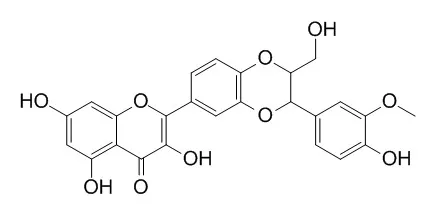| Structure Identification: |
| Planta Med 2013; 79 - P37. | | Flavanolignans from Silybum marianum L. – Chemistry and Characterization as Primary Phyproof® Reference Substances.[Reference: WebLink] | Since ancient times milk thistle (Silybum marianum L.) fruits are known to have medicinal properties. Cultivation began more than 2000 years ago and was especially popular in Germany, Greece and Italy. The active principal is a mixture of various flavanolignans known as silymarin, located in the pericarp and isolated and structurally characterized for the first time in the 1960 s. Recognized medicinal application areas are the supportive treatment of chronic inflammatory liver disorders and cirrhosis of the liver as well as the intravenous treatment of toxic liver damage (e.g. Amanita mushroom poisoning). Completely new areas of application opened up in the 1990 s after it was discovered that silymarin and isolated flavanolignans inhibited the spread of tumor cells.
METHODS AND RESULTS:
According to the Pharmacopoea Europaea silymarin is a mixture of silybin A and B, isosilybin A and B, silychristin and silydianin. These flavanolignans originate biosynthetically from the radical oxidative coupling of taxifolin with coniferyl alcohol. Resulting products are characterized by the flavanolignan skeleton with the molecular formula C15H22O10 and a molecular weight of 482.4 g/mol. Due to its low stereoselectivity this reaction produces trans-configured diastereoisomeric pairs. To distinguish the A and B forms measurement of optical rotation and CD spectra are required, while identification based on HPLC retention times alone is error-prone. It is noteworthy that the pharmacological activity and mode of action of the various diastereoisomers differs significantly.
CONCLUSIONS:
The isolated flavanolignans silybin A and B, isosilybin A and B, silychristin, silydianin as well as 2,3-Dehydrosilybin A and 2,3-dehydrosilybin B were characterized as primary reference substances according to international guidelines. These compounds, now available in a certified quality for the first time, can be applied in the quality control of milk thistle preparation as well as in pharmacological research. They will hopefully assist in broadening the knowledge on these fascinating natural compounds. |
|






 Cell. 2018 Jan 11;172(1-2):249-261.e12. doi: 10.1016/j.cell.2017.12.019.IF=36.216(2019)
Cell. 2018 Jan 11;172(1-2):249-261.e12. doi: 10.1016/j.cell.2017.12.019.IF=36.216(2019) Cell Metab. 2020 Mar 3;31(3):534-548.e5. doi: 10.1016/j.cmet.2020.01.002.IF=22.415(2019)
Cell Metab. 2020 Mar 3;31(3):534-548.e5. doi: 10.1016/j.cmet.2020.01.002.IF=22.415(2019) Mol Cell. 2017 Nov 16;68(4):673-685.e6. doi: 10.1016/j.molcel.2017.10.022.IF=14.548(2019)
Mol Cell. 2017 Nov 16;68(4):673-685.e6. doi: 10.1016/j.molcel.2017.10.022.IF=14.548(2019)